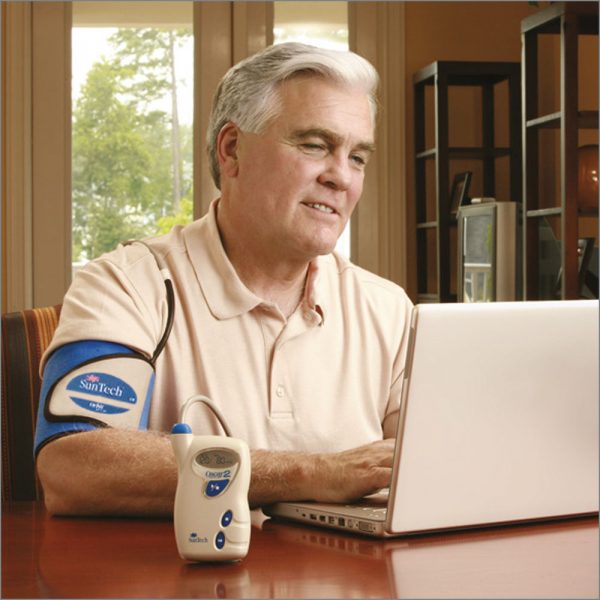Ambulatory Blood Pressure Monitoring – An Invaluable Tool in Diagnosing and Treating Hypertension
According to the World Health Organization’s (WHO) statistics in 2017, hypertension is the leading cause of mortality worldwide. It is estimated that there are about 1.3 billion patients with hypertension, of which 50% are unaware of their condition. That’s why regular blood pressure monitoring is essential, and one comprehensive method for monitoring and diagnosing hypertension is Ambulatory Blood Pressure Monitoring (ABPM).
What Is Ambulatory Blood Pressure Monitoring?
Ambulatory blood pressure monitoring (ABPM) is a device used for continuous blood pressure monitoring over an extended period, typically 24 hours, to record the patient’s blood pressure fluctuations during this time. It is used to predict hypertension, helping the doctor determine blood pressure levels throughout the day and night, as well as analyze blood pressure variations in different situations.
Ambulatory Blood Pressure Monitoring is designed to be compact and easy for patients to carry during the monitoring period. It consists of a portable blood pressure machine worn as a belt, a blood pressure cuff around your arm connected to a data recorder, and typically, the recorder has a button for patients to mark the occurrence of symptoms. Throughout the time the patient wears the device, it automatically records blood pressure values within the set time intervals and provides data analysis to support healthcare professionals.

The Oscar 2 Ambulatory Blood Pressure Monitor from SunTech Medical
The diagnosis of hypertension with ABPM helps provide more detailed information about blood pressure in the patient’s daily activities, helping doctors make a more accurate diagnosis and choose the right therapy to treat hypertension.
The Outstanding Value Of ABPM In Diagnosing And Treating Hypertension
- Diagnosis of hypertension
ABPM (Ambulatory Blood Pressure Monitoring) allows for continuous blood pressure recording over an extended period, typically 24 hours or more. This enables doctors to accurately assess real-life blood pressure fluctuations during the patient’s daily activities, including during sleep and various physical activities. At the same time, ABPM provides detailed information to observe any abnormal signs and pathological symptoms exhibited by the patient throughout the day.
ABPM can measure and store blood pressure readings with high accuracy, unaffected by external factors, thus avoiding inaccuracies that may occur with conventional blood pressure measurement methods.
Ambulatory blood pressure monitoring can detect abnormal changes in BP that might otherwise go unnoticed. It’s a useful way to detect different blood pressure patterns, as listed below.
White coat hypertension
White coat hypertension, or white coat syndrome is a condition in which people have normal blood pressure at home have elevated blood pressure in a healthcare setting. It is worth noting that white coat hypertension can lead to false suspicions about a diagnosis of hypertension when your actual blood pressure is normal, however “white coat syndrome” is a manifestation of people at risk of metabolic syndrome, silent heart attack, hypertension, and diabetes later. This condition occurs in 10% – 30% of people with elevated blood pressure readings in healthcare settings.
Masked hypertension
Hidden or masked hypertension occurs when your blood pressure is normal at the healthcare provider’s office but rises at other times. This condition can affect up to 30% of adults and is relatively difficult to detect. If you have kidney disease, diabetes, or experience breathing difficulties due to obstructive sleep apnea, you are at a higher risk of hidden hypertension.
Nocturnal hypertension
Nocturnal hypertension refers to elevated blood pressure during sleep. This condition is more common in people with diabetes or kidney disease and may be associated with cardiovascular diseases. Ongoing studies continue to reveal significant associations between elevated nighttime blood pressure and cardiovascular pathologies.
Sustained hypertension
This refers to elevated blood pressure readings, whether in your provider’s office or at home. Researchers have linked this condition to an increased risk of heart and kidney damage, as well as stroke.
- Predicting prognosis
ABPM measurements help detect abnormal blood pressure patterns during our daily activities, allowing for the prediction of cardiovascular events and target organ damage (mortality rates, coronary artery events, and strokes). This aids doctors in implementing early preventive measures and better management.
- Assess the progress of treatment
Furthermore, ABPM data can be used to assess the progress of treatment. After the doctor prescribes a treatment plan, the data from ABPM can be utilized to evaluate the patient’s changes and responses during the course of treatment, as well as determine the effectiveness of medications and therapies, leading to necessary adjustments if required.
ABPM plays a crucial role in monitoring blood pressure and predicting blood pressure-related issues, contributing to improved healthcare quality and theel prevention of cardiovascular diseases, hypertension, and kidney function problems.
Clinical Indications For ABPM
- Large blood pressure fluctuations between measurements
- Experiencing symptoms but having normal blood pressure readings at healthcare facilities
- Suspecting white coat hypertension or masked hypertension
- Hypertension during pregnancy
- Nocturnal hypertension
- Diagnosing and screening for target organ damage
- Collecting information to determine the pathological condition
- Assessing the effectiveness of the treatment protocol
What Is Good Ambulatory Blood Pressure?
Table: High blood pressure assessment with ABPM
| Result | Systolic BP | Diastolic | Normal readings | |
| Daytime blood pressure | ≥135 | or | ≥85 | <120/80 (mmHg) |
| Nighttime blood pressure | ≥120 | or | ≥70 | <105/65 (mmHg) |
| 24-hour average | ≥130 | or | ≥80 | <115/75 (mmHg) |
You are diagnosed with hypertension when the following parameters are met:
- Daytime blood pressure: a systolic blood pressure greater than 135 mmHg or a diastolic blood pressure greater than 85 mmHg
- Nighttime blood pressure: a systolic blood pressure greater than 120 mmHg or a diastolic blood pressure greater than 70 mmHg
- 24-hour average: a systolic blood pressure greater than 130 mmHg or a diastolic blood pressure greater than 80 mmHg
Important Considerations When Using ABPM
When using ABPM, there are some important notes you should follow to ensure an effective and reliable monitoring process. Here are the key points to remember:
- Follow instructions: Make sure you fully understand and comply with specific instructions from your doctor or healthcare professional on how to use and wear the ABPM device. They will guide you on the care, removal, and maintenance of the device during the monitoring period.
- Properly wear the device: Ensure that the blood pressure cuff is securely, but not too tightly fastened around your arm. This helps ensure accurate and reliable data recording.
- Record activities: Throughout the monitoring process, keep a record of your activities and the corresponding time to provide an overall insight into your health status and stress levels throughout the day.
- Avoid water exposure: Prevent water or moisture from coming into contact with the device as it may damage the equipment and lead to data loss.
- Avoid external impacts: Be cautious to avoid any external forces that may interfere with the functioning of the ABPM device.


